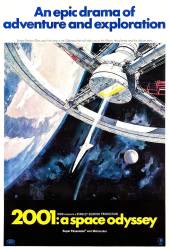Revealing mistake: During the "Dawn of Man" sequence, the ape-man scenes were shot on an indoor stage with projected background images on a huge screen behind the stage. The screen itself was a highly reflective cloth. In most shots, it is quite convincing, but in several (especially when facing the aggressive, victorious group during the first fight, then again when facing the tool-using group in the last fight), the rear screen appears to be a patchwork of smaller pieces of cloth as very obvious puzzle-like shapes of varying reflectivity appear in the sky. Once you notice them, it's incredibly distracting. It was originally parallel strips, but they were VERY visible as vertical lines so they were torn into a patchwork to make lines less obvious. (00:08:35 - 00:18:00)

2001: A Space Odyssey (1968)
Plot summary
Directed by: Stanley Kubrick
Starring: Gary Lockwood, Keir Dullea, William Sylvester, Daniel Richter
A few million years ago, in Africa's Olduvai Gorge, our ancestors were starving, defenseless prey to predators, and on the verge of extinction. An advanced civilization from the stars (never shown) spots our potential and gives our brains a boost by means of a monolith. (Symbolic dimensions 1x4x9 --the squares of 1, 2 and 3) In 2001 a monolith is found buried on the moon. When sunlight hits it, it sends a radio message to a Jupiter monolith-relay, telling the aliens that we have arrived. A space craft is sent to Jupiter on a secret mission to check it out. One member of the crew is HAL -- a sentient, self-aware computer. Unfortunately HAL has been instructed to lie -- something contrary to his very nature. This drives him to desperate measures.
Dave Bowman: Open the pod bay doors, HAL.
HAL: I'm sorry Dave, I'm afraid I can't do that.
Trivia: The leopard lying on a dead zebra was actually lying on a dead horse painted to look like a zebra. The cat wasn't too happy with that scene.
Question: Maybe I need to read the book, but can someone explain the whole ending sequence to me. Why all the flashy over dramatized pictures? It's artistic but is there some other meaning to it?
Answer: At the end, in the Arthur C. Clarke's story, both Dave Bowman and Frank Poole (who survived) went to a moon of Saturn to investigate the second Monolith. Dave Bowman tried to touch the Monolith with his space pod and was sucked into a wormhole that transported him to a star on the other side of the universe - at which point, Dave's last transmission is "My God, it's full of stars!" All of the "slit-scan" visual effects by Doug Trumbull (based on effects created by John Whitney years earlier) represent an almost instant voyage to the other side of the universe. Whether this is supposed to be a quantum-jump is not explained, but it's millions of times faster than anything ever depicted in Star Trek or other space fantasy knockoffs.
Frank does not survive in the book; he is killed by HAL just as in the film.





Chosen answer: All the flashing images are supposed to represent Bowman travelling past far and distant galaxies, this is what happens in the book, where he travels to that white house place.
troy fox